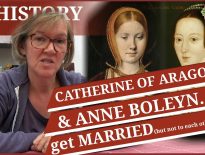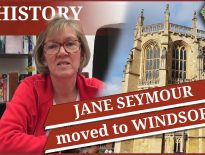On this day in Tudor history, 13th November 1553, in the reign of Queen Mary I, the former queen Jane, or Lady Jane Grey, was tried for treason at Guildhall in London. She wasn't the only one tried, her husband Lord Guildford Dudley, his brothers Ambrose and Henry Dudley, and Thomas Cranmer, Archbishop of Canterbury, were also tried for treason for their parts in putting Jane on the throne.
In today's talk, I explain what happened at their trial and also what happened to these Tudor people after they were found guilty and condemned to death.
You can find out about Lady Jane Grey and Lord Guildford Dudley's executions in my video from 12th February and you can find about Thomas Cranmer's end in my video from 21st March- see below.
Also on this day in history:
- 1536 – Murder of Robert Pakington, mercer and member of Parliament, at Cheapside, while making his way to mass at St Thomas of Acre Chapel. Read more here.
- 1537 – Burial of Jane Seymour, Henry VIII's third wife, at St George's Chapel, Windsor Castle. Henry VIII's daughter, Mary, acted as chief mourner.
- 1537 – Margaret Tudor, the former Queen of Scotland, wrote a letter to her brother, Henry VIII. Margaret was desperately unhappy. She had married her third husband, Henry Stewart, 1st Lord Methven, in 1528, and was intent on divorcing him because not only did he have a mistress, he was also spending and wasting Margaret's money. Margaret's own son, James V of Scotland, was siding with Methven and Methven had control of Margaret's lands and money, so Margaret wanted her brother's support and help. Read Margaret's letter here. Unfortunately for Margaret, her brother was reluctant to help and, as her biographer Richard Glen Eaves notes, he would not invite her to England "and in her last years practically ignored her."
- 1601 – Burial of Lady Mary Ramsey (née Dale), famous philanthropist, at Christ Church in London.
- 1612 – Death of Sir George Carew, administrator, member of Parliament and diplomat, from typhus at his home in Tothill Street, Westminster, London. He was buried at St Margaret's Church, Westminster. Carew's served as secretary to Lord Chancellor Hatton and served Elizabeth I and James I as an ambassador.



Not only a show trial, all in one day but a sermon first as well.
Jane was sustained by a fast faith, but she may also have felt she wouldn’t die either. Her fate was decided outside of her control with her father’s foolish decision to join Thomas Wyatt.
Ambrose Dudley has a magnificent tomb in the same chapel as his younger brother, Robert Dudley and Lettice Knowles in the Beauchamp Chapel of the Collegiate Church in Warwick. Obviously this was a show trial and Mary pardoned those who were not involved in plots, treason and other people’s machinations. I believe Mary tried to save Jane but her Council advised her otherwise. A myth exists that it was Philip who wanted Jane out of the way but he wasn’t even in England and more expert writers have shown this theory is nonsense. The Spanish Ambassador may have dropped a hint but Mary took counsel on this from several sources before signing the final warrant and allowing the death sentence to be carried out.